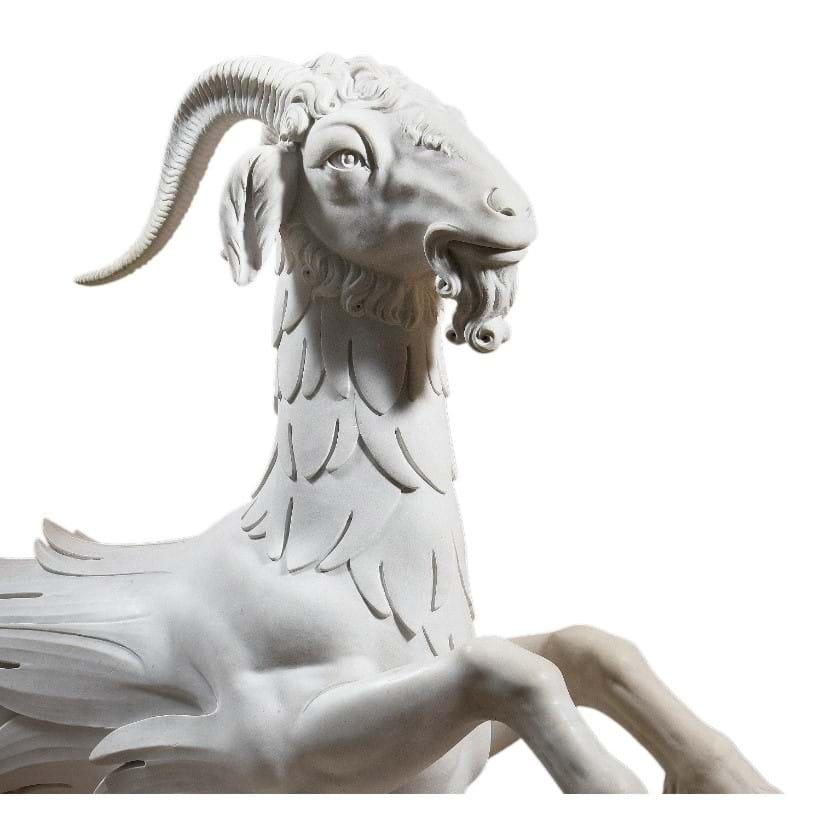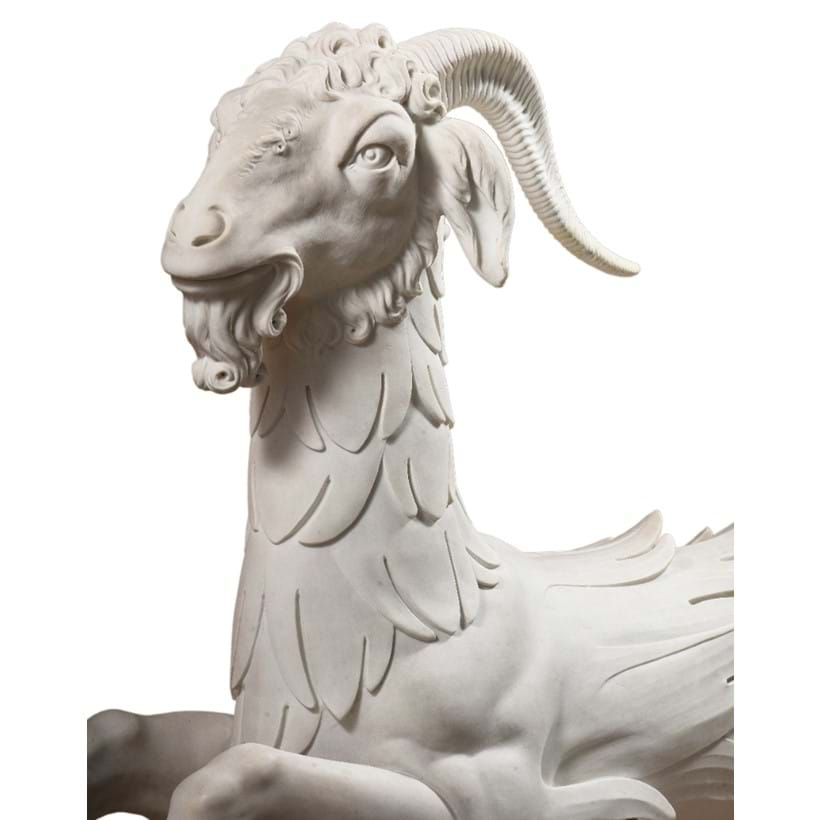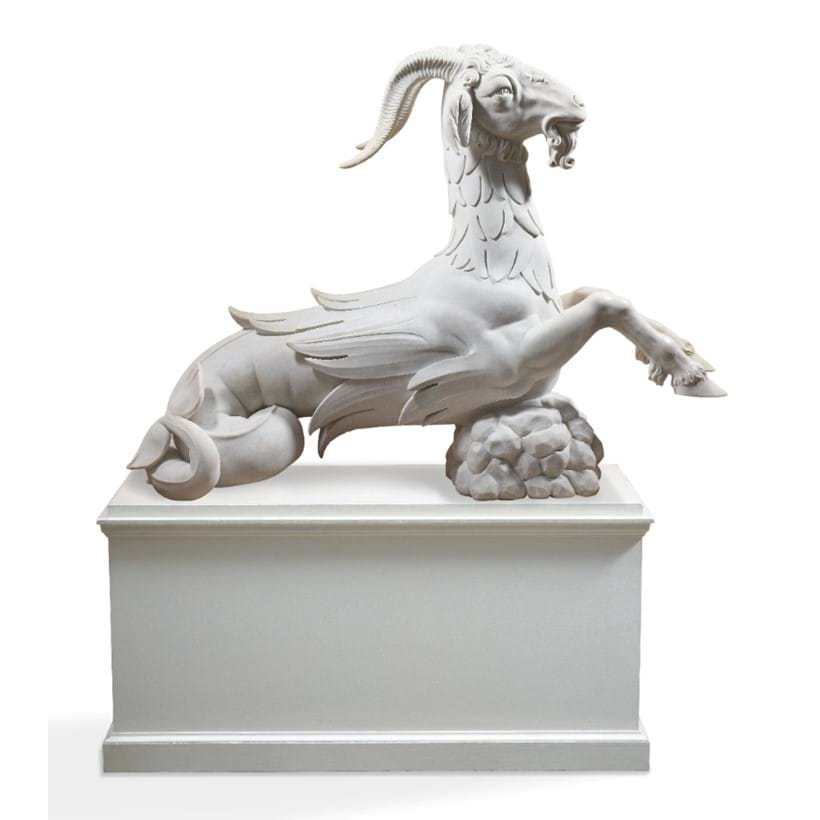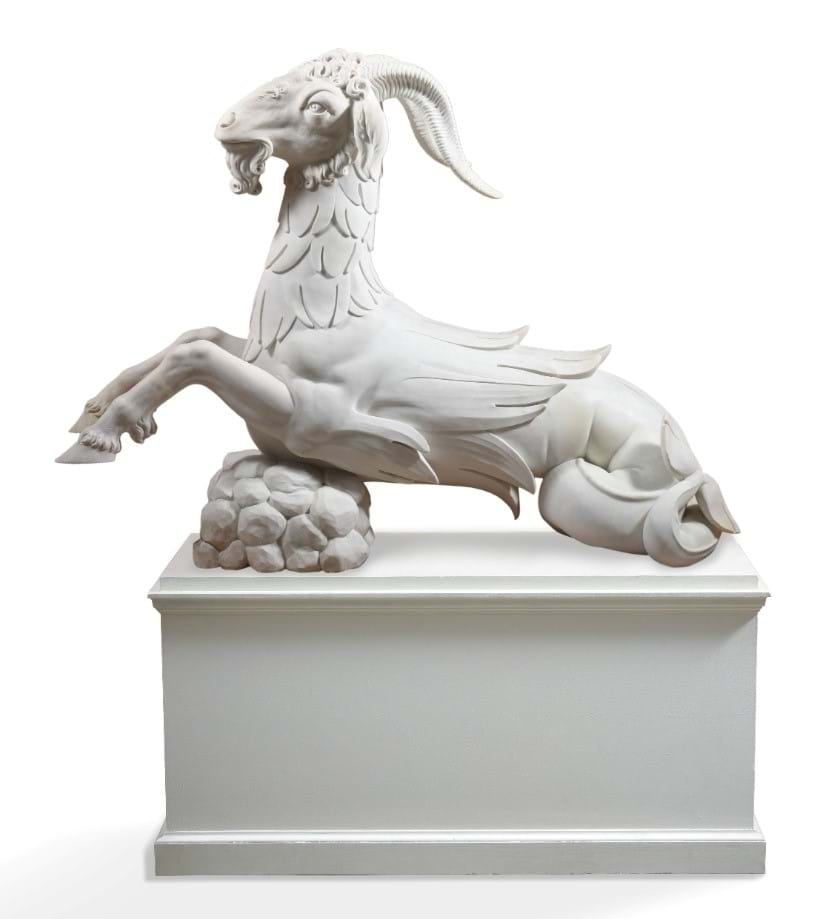A magnificent pair of marble Capricorns | The Collection of Count Manfredi della Gherardesca
One of the highlights of the auction Alchemy of Design: The Collection of Count Manfredi della Gherardesca, taking place on Wednesday 24 April 2024, is Lot 280, a magnificent pair of marble Capricorns attributed to Innocenzo Spinazzi (1726-1798) and possibly commissioned by Grand Duke Pietro Leopoldo (later Emperor Leopold II) for an unrealised restoration scheme for the Boboli Gardens.
These outstanding marble Capricorns are exceptional for their size, quality and condition, as well as for the rarity of the subject matter in Italian sculpture. The model originates in 16th century Florence, created to decorate monumental gate posts in the Boboli Gardens, the famous park connected to the Palazzo Pitti, attributed to a sculptor from the circle of Bartolomeo Ammannati (1511-1592).
The originals flank the entrance to the Isola, a part of the gardens that has Giambologna's magisterial Oceanus fountain at its centre. The Capricorn was an important emblem for Cosimo I de' Medici (1519-1574), for whom the star sign was ascendant, and its use here may have been an homage to Lorenzo il Magnifico, the late 15th century Medici ruler, who was born on 1 January 1449, making him a Capricorn.
Lot 280:
ATTRIBUTED INNOCENZO SPINAZZI (1726-1798) ITALIAN, FLORENCE, CA. 1775
PAIR OF CAPRICORNS
Marble
each 115 by 154cm
Est. £80,000-120,000 (+ fees)
Provenance:
Possibly commissioned by Grand Duke Pietro Leopoldo (later Emperor Leopold II) for a scheme in the Boboli Gardens, Florence
Giovanni Pratesi Antiquario, Florence, where purchased by Count Manfredi della Gherardesca
Literature:
- Capecchi, I Capricorni di Pietro Leopoldo. Innocenzo Spinazzi e le sculture di Boboli in età neoclassica, Florence, 2011;
- Roani, Innocenzo Spinazzi, Florence, 2019, pp. 36-37, pp. 66-67, no. 7
Related Literature:
- Capecchi, Cosimo III e le arti di Boboli. Committenza, iconografia e scultura, Florence, 2008, pp. 64, 186-7;
- Capecchi, D. Pegazzano, S. Faralli, Visitare Boboli all’epoca del Lumi. Il Giardino e le sue sculture nelle incisioni delle ‘Statue di Firenze’, Florence 2013;
- González-Palacios, Il Serraglio di Pietra. La Sala degli Animali in Vaticano, Città del Vaticano, 2013
By the middle of the 18th century, the Boboli Gardens had fallen into disrepair. With the arrival of the Lorrainese Grand Duke Pietro Leopoldo (later Emperor Leopold II) at Florence in 1770, a programme to restore the Gardens was initiated. The commission given to Innocenzo Spinazzi (1726-1798) is documented between 1775-1777. The Roman sculptor was required to repair, copy and restore the sixteenth- century Capricorns, which were eventually reinstalled in the Boboli Gardens.
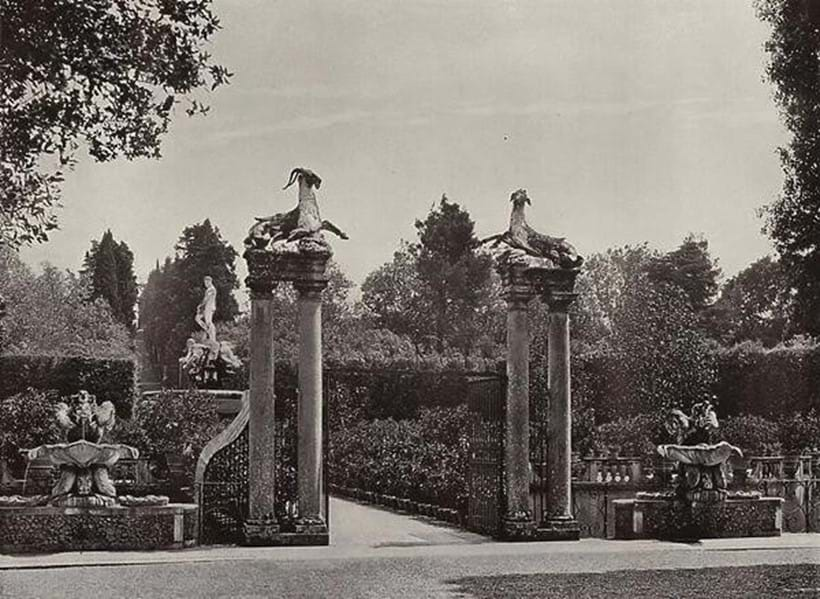
Innocenzo Spinazzi: A Roman Sculptor at the Dawn of Neoclassicism
Spinazzi’s career as a sculptor is divided between Rome and Florence and spans a transitional stylistic period between the late Baroque and Neoclassicism (Roani, op. cit., p. 36). He was taught by Giovanni Battista Maini (1690-1752), a contemporary of Filippo della Valle (1698-1768), Edme Bouchardon (1698-1762) and Pietro Bracci (1700-1773) - all sculptors working in Rome in the second quarter of the 18th century. Among Spinazzi’s own generation of sculptors were Bartolomeo Cavaceppi (1716-1799), Francesco Antonio Franzoni (1734-1818) and Carlo Albicini (1724-1817), all active in Rome; the English sculptors, Francis Harwood (1727-1783), Christopher Hewetson (c.1736-1798) and Joseph Nollekens (1737-1823); and, in France, Clodion (1735-1814). The rise of Neoclassicism is manifest in the work of all of these eminent late eighteenth-century sculptors.
Spinazzi’s father was a silversmith which gave him a fluency working in bronze and other metals, but his early style was mostly influenced by Giovanni Battista Maini, whose teacher Camillo Rusconi (1658-1728) was an adherent of the high Roman Baroque, personified by the great Gianlorenzo Bernini (1598-1680). A key early work executed when Spinazzi was twenty-nine years old, that demonstrates his master’s Baroque influence is the large marble group of St Joseph Calasanctius made in 1755 for St Peter’s Basilica in Rome. The Saint is shown in heavy, voluminous drapery conceived in broad,
flat planes.
His stern sobriety contrasts with the two lively attendant boys reading a book. Two years later, Spinazzi made the Monument to Cardinal Gioacchino Besozzi in S. Croce in Gerusalemme, Rome. The eagle at the foot of the altar at which Cardinal Besozzi is shown praying provides a point of comparison with his later work on the Capricorns. While the dynamism of the eagle’s dramatically spread wings and twisting body is archetypically Baroque, the eagle’s crisply carved feathers is echoed in the treatment of the Boboli Capricorns produced almost twenty years later. During his Roman period, Spinazzi gained renown for his reproductions of Antique statues, such as the Callipygian Venus, his final collaboration with his master Maini, and the Venus de’ Medici, today in the National Galleries of Scotland (inv. NG 2590). When the Grand Duke of Tuscany visited Rome in 1769 it was doubtless this aspect of Spinazzi’s oeuvre that motivated him to invite the sculptor back to Florence, to appoint him Primo Scultore di Corte, and promptly put the sculptor to work on similar projects.
Spinazzi in Florence
Spinazzi’s most famous sculpture from his Florentine period is undoubtedly his virtuoso carving of Faith (1871) in S. Maria Maddalena dei Pazzi. Faith is shown as a woman veiled from head to toe, her face and body visible through the diaphanous drapery that covers her. Over the next twenty years, he executed several major monuments in Santa Croce and in other Florentine churches. Amongst his first Grand Ducal commissions in Florence were restorations of Antique statues being moved to the Tuscan capital from the Villa Medici in Rome and elsewhere. He restored the famous Niobe statues and the Apollino, and in 1773 he worked on 42 sculptures from the Pratolino Park that had lately been sold by the Grand Duke. His work on the renovation and restorations in the Boboli Gardens were a natural progression from these commissions.
The Boboli Gardens Commission
The Capricorns are the crowning achievement of Spinazzi’s work in the Boboli Gardens project initiated by Grand Duke Pietro Leopoldo. This aspect of his career has been studied in depth by Prof. Gabriele Capecchi, who has written extensively on the Boboli Gardens (see related literature) and has authored a volume dedicated to these Capricorns that details all the related documents (Capecchi 2011, op. cit.), and to which the present text is indebted. These Capricorns are also published by Roberta Roani (op. cit.).
Capecchi has published a series of documents issued by the Scrittoio della Fortezza e Fabbriche in the 1770s which relate to the programme of restoration in the Boboli Gardens (see appendix for English translations of the key documents). A document dated 27 January 1776 describes the Vasca detta dell’Isola that needed restoration to the sculptures, which included four Capricorns described as by Giambologna and his assistants; Capecchi attributes them to the circle of Ammannati, a contemporary of Giambologna. This document details how two of the statues had been delivered to Spinazzi’s studio to be repaired and specifies that two casts were to be taken, from which four statues were required to be made. (Lo Scrittoio ... ha fatto portare due di queste vecchie statue allo studio dello scultore Spinazzi e le [h]a fatte risarcire alla meglio, tanto che dalle medesime si potessero cavare due figure, per poter sopra quelle copiare esattamente le nuove statue’). The work on the four animals was to be divided between Spinazzi, Francis Harwood and Capezzóli in order to expedite the completion of the work and relieve Spinazzi to focus on other work for the Grand Duke.
The documents go on to specify the high-quality marble needed for these new copies which was to be brought directly from Carrara, because the quality of the existing marble in the warehouse at S. Lorenzo was inadequate. The documents note that Spinazzi was working on this commission with an assistant, Giuseppe Belli, and the plaster casts were made by the specialist craftsman, Niccolò Kindermann. The documents also describe additional work done by Harwood and Capezzóli on the figures of Tritons, based on Spinazzi’s design.
Work continued throughout 1776, and into the following year. By July 1777, the initial plan to replace the 16th century Capricorns with new ones was altered, presumably due to pressure of time and lack of funds, in favour of restoring the original marbles attributed to the circle of Ammannati by adding new heads, horns and tails. The four restored statues were transported back to the Boboli Gardens and reinstalled on 26 August 1777 (Capecchi 2011, op. cit., pp. 16, 20). A document dated 15 July 1777 confirms that Spinazzi and Kindermann were paid for their work.
The present pair of marbles fit with the description of the Capricorns in these documents. It is apparent, however, that they vary in many details from the existing Capricorns in the Boboli Gardens. The carving of the hair on the heads, the anatomy of the mouths and the carving of the eyes are all different. It is notable that the tails differ between the four existing Capricorns in the Boboli Gardens, two having their tails pointing down and two pointing up. The present Capricorns are consistent with the latter. These inconsistencies bring into question which animals in the Boboli Gardens are the work of Spinazzi, Harwood and Capezzóli, and why the present marbles are different. Capecchi seems to indicate that the present Capricorns may have been intended for a scheme related to the Grotta Grande in the Boboli Gardens (Capecchi 2011, op. cit., p. 26, fig. 9), although there does not appear to be any documentary evidence.
Spinazzi’s Capricorns in context
In approaching the commission to restore and copy the Capricorns, Spinazzi brought a wealth of experience he had gained working with ancient sculpture in Rome, which had surely recommended him to the Grand Duke five years previously. Certainly, he was a skilled restorer of ancient Roman statues, and made exact, high-quality copies, such as the Venus in Scotland mentioned above. The Capricorns are of the same genre, but distinct in their animal subject matter. Here, his source is not Antiquity, but a 16th century model. In the late 18th century, the Boboli Capricorns were believed to be by the great Giambologna, whose sculptures - such at the Abduction of a Sabine in the Loggia dei Lanzi, Florence - were reproduced for the Grand Tourists with the same reverence afforded to antique marbles. It is natural, then, that Spinazzi would have approached his commission first to copy and then to restore the Capricorns with great respect to the originals. This may account for the clear differences between the heads of the Capricorns in the Boboli Gardens and the present pair: the eyes of the animals in situ are un-carved; the form of the snout and tail are different; the hair is depicted with shorter, more deeply carved curls; and the handling of the mound of rocks is also quite different. So, for his restoration, Spinazzi appears to have reproduced the style of the 16th century Capricorns in the parts he added, and these additions vary from his own interpretation shown in the present Capricorns. Spinazzi’s later interventions in the famous Grotta degli animali in the garden of the Villa medicea di Castello offer additional comparison for the style of his animal carving. He was involved on the Grotta around 1791-2, working on the marbles of the wild boar and the doe. The carving of the Castello boar’s rough coat contrasts with the smooth surfaces of the Capricorns’ bodies. The handling of the fur on the doe is closer to the Capricorns, but the eyes, like those of the boar, are blank. It is also worth noting that these Capricorns do not have the highly polished surface that the sculptor used in his formal marble portrait bust of Grand Duke Pietro Leopoldo in the Palazzo Pitti, Florence, which may indicate the expectation that they would not be viewed from close quarters, but rather form a focal point in an interior ensemble.
During the first half of his career working in Rome, Spinazzi would have surely studied and probably worked on some of the spectacular animal sculptures made in ancient Rome. Around the date that he left Rome, many of these animal statues were being brought into the papal collections where the Sala degli Animali was opened in the Vatican by Pius VI (1775-1799). Here, there are many representations of goats, such as the Head of a Goat (inv. 354) or the Capra Selvatica (inv. 521) that could have been exempla for Spinazzi in working on these Capricorns. Francesco Antonio Franzoni’s restoration to the Tigre Marina (inv. 453) provides a most illuminating comparison of a contemporary sculptor working on a similar commission. The Tigre Marina is an extraordinary animal formed of the head and front legs of a tiger and the tail of a fish - the flat pointed scales of the animal’s lower body are similar to the Capricorns.
Capricorns: Myth and Meaning
The history of the Capricorn is thought to date back to the Sumerian and Babylonian civilisations in Mesopotamia that had already associated the constellation with the god Enki. In Greek mythology, the Capricorn is linked to the god Pan, with his goat’s legs and horns. Zeus immortalised Pan as a constellation in gratitude for both his involvement in the battle against the Titans and for warning the gods about the approaching monster, Typhon. To avoid the fearsome monster, Pan jumped into the river Nile and turned the lower part of his body into the shape of a fish. It has also been linked to the goat Amalthea, which suckled the infant Zeus. The constellation of Capricornus is located in the southern sky - it is the 40th biggest constellation and is made up of five named stars. Capricorn is the tenth astrological sign in the zodiac, through which the sun moves from around 22 December to 19 January. It is one of the three earth signs, with Taurus and Virgo, one of the four cardinal signs, and a feminine sign.
Appendix
Translations of selected documents relating to the restoration of the Boboli Garden Capricorns. The Italian texts are published in Capecchi 2011 pp. 141-145.
22. 1776 January 27 – February 13. Arrangements for the remaking of the Tritons and Capricorns
ASFi, Scrittoio delle Fortezze e Fabbriche, Fabbriche Lorenesi, f. 1988 ins. 10
Record of the Scrittoio delle RR. Fabbriche, 27 January 1776
Among the various works that he has commissioned for his Royal Boboli Garden, His Royal Highness ordered that four statues around the so-called Vasca dell’Isola, two by Gio. [van] Bologna and two by one of his pupils, should be remade. These statues depict four sea monsters, but time has rendered them barely recognisable and they are damaged in many places.
The Scrittoio, to comply with this order, has arranged for two of these antique statues to be taken to the studio of the sculptor Spinazzi and has had them restored as well as possible, so that from them two figures have emerged, from which the new statues can be copied exactly. Two casts will be needed for this work, because for the four statues required, each two will be pairs.
Additionally, the Scrittoio has ordered from Carrara the marble needed to make the new statues, weighing about 30,000 libbre, since the marble in the S. Lorenzo stores was not suitable for such work.
This week, the two casts will be finished and immediately afterwards work on the statues can begin. If His Royal Highness approves what the Scrittoio has had the honour of proposing to him, two can be made in the studio of the sculptor Spinazzi and can be worked upon at the same time by Spinazzi and his assistant Belli, who will work under the former’s direction; nevertheless they will take more than three months to complete. For the other two, one will be made by the sculptor Harvood [stet], called the Englishman, and the other by the sculptor Capezzóli, who has recently returned from England and all four can probably be finished at the same time, that is to say about the beginning of next June. The cost of these statues will be far from negligible because just the marble transported to Livorno cost 922.13.14 lire; transport from Livorno to Pignone 589.15 lire; and from Pignone to the various studios belonging to the above sculptors 282 lire. In addition to these expenses, there is the casting of the statues which will cost 350 lire and then we will have to pay the two sculptors Harvood and Capezzoli who will want not much less than 100 zecchini each. If we had asked Spinazzi to make all four, it seems we would have saved 200 zecchini, but the work would have taken him more than a year, so it would hardly have been worth it and meanwhile there would have been delays to the other Boboli works, the restoration of the Niobe and other things that need doing in the Royal Gallery; nor would it have encouraged the other sculptors if we had not given them any wIf His Royal Highness approves of what has been done and what remains to be done to fulfil his sovereign commands, the Scrittoio will press for the completion of these works, which will cost about 5000 lire.
Francesco Piombanti, Secretary
Rescript: This is approved, let it be done as is proposed. Florence, 13 February 1776 Pietro Leopoldo
23. 1776 July 9. Payments to Kindermann, the ‘formatore’ (mould maker), for the cast of the Capricorns
ASFi, Scrittoio delle Fortezze e Fabbriche, Fabbriche Lorenesi, f. 65
c.nn [sent] n. 51
9 July 1776
To Niccola Kinderman, mould maker, for the casts of the Boboli Capricorns, 100 lire Francesco Piombanti
c.nn.
7 August 1776
For that I, Niccola Kindermann, caster of statues, on the orders of the Most Illustrious Signore Francesco Piombanti, Secretary of the Reali Fabriche, made two plaster moulds of the two sea-goats on the four columns at the entrance to the Isola del Reale, Boboli Gardens and made the two corresponding casts in gesso, one for each type, the above work agreed at two hundred and eighty lire, 280 lire [after adjustment] 240 lire.-.-
And since the above goats lacked tails, I have made a mould from the terracotta model made by His Royal Highness’s sculptor Innocenzo Spinazzi, and have cast them in gesso so that they might be completed, thirty-five lire, 35 lire [after adjustment] 20 lire.-.-
I have also cast a head with necks (?sic) and cast one of the two Tritons, for use by Monsieur Francesco Arvord [stet] sculptor, twenty-one lire, 21 lire [after adjustment] 13 lire.-.- And also I have made two small moulds of a hand and an arm and cast them and assembled them for one of the Putti surrounding the Isola for use by the above named Signore Innocenzo Spinazzi, to be made in marble, six lire, 6 lire [after adjustment] 5 lire.-.-
Received on account 100 lire
Rescript: 13 August 1776
The works described in the present bill were completed by Niccola Kinderman and they come to three hundred and seventeen lire in witness whereof
Giovan Battista Ruggieri
25. 1777 June 11 – 1778 September 18. Bill from the bronze caster Pietro Cioci for the metal parts of the restored Capricorns.
ASFi, Scrittoio delle Fortezze e Fabbriche, Fabbriche Lorenesi, f. 77
c.nn.
I.M.I 1777
The Scrittoio delle Fabbriche di SAR owes me, Pietro Cioci, bronze caster, for the following works undertaken for the Boboli
– 11 June [1777] For having made two pairs of horns half tin and half lead with a big copper pin in the middle with which to attach them, for both goats, 84 lire [after adjustment] 63 lire
On 18 September 1778
Pietro Cioci supplied the above work priced at sixty-three lire in witness whereof I confirm 63 lire
Zanobi del Rosso, architect
27. 1777, July 15 Work done by the mould maker Kindermann on the original Capricorns ASFi, Scrittoio delle Fortezze e Fabbriche, Fabbriche Lorenesi, f. 80
c.nn
sent no. 83, called ‘Gallery and annexes’ quartale of September 1778
I.M.I
15 July 1777
Since I the above named Niccola Kinderman, caster in gesso, on the orders of Signore Innocenzio Spinazzi the sculptor, have cast two antique torsos of goats in marble and respectively have cast the terracotta models of the eight legs (tails?), two posts for support under the body and two bases with rocks, with their heads and two tails and decorations, comprising twenty moulds and I have added olio cotto [boiled linseed oil] to these moulds and I have made casts from these moulds twice for each mould, one of which is for the pointing and the other is for assembling for the copy, 62 lire [after adjustment] 52 lire
The entirety for the service of the Royal Gallery
I, Innocenzio Spinazzi, confirm the above, in my own hand
3 August 1778
Niccolo Kindermann did the above work and it cost fifty two lire in witness whereof Giovan Battista Ruggieri, architect, in his own hand.
With thanks to Alexander Kader FSA for his assistance in cataloguing this lot.
View page turning catalogue
Auction Details
Wednesday 24 April, 10.30am BST
Donnington Priory, Newbury, Berkshire RG14 2JE
Browse the auction
Sign up to email alerts
VIEWING:
- Viewing in Newbury:
- Saturday 20 April: 10am-3pm
- Sunday 21 April: 10am-3pm
- Monday 22 April: 10am-4pm
- Tuesday 23 April: 10am-4pm
- Wednesday 24 April: 10am-4pm
- Dreweatts 360 Virtual Auction Tour | Available from Saturday 20 April













